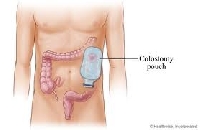When patients can expect reversal of colostomy
By Catalogs Editorial Staff

A colostomy can, at times, be reversed once the bowels have healed
Sometimes a person must get a colostomy because of disease or injury. A colostomy is a procedure that creates an opening in the abdominal wall. The end of the large intestine, which is the colon, is brought through the opening to form a stoma. A stoma is an artificial opening that is made in an organ in the body and is done, when necessary, in the colon via the abdomen.
At times, a colostomy is temporary and is done to give the bowel a chance to rest if the individual has been experiencing chronic bowel problems. The colostomy gives the bowel a chance to mend, which can take weeks or months and sometimes even years. When the bowel is mended, the colostomy may be reversed.
A colostomy allows stool to pass which it is unable to do naturally due to a disease or an injury. The anus is no longer the exit from which stool leaves the body. The rectum and colon are either removed or disconnected. Whether permanent or reversible, patients who have colostomies are dependent upon special ostomy medical supplies for a period of time.
Some colostomies are done on the left side while others are done in the middle of the abdomen or on the right side. Some are large; some are small.
The stoma is the mucosa or lining of the intestine. It is pink or red and is moist, warm and issues small amounts of mucus. Some stomas stick out whereas other are flush with the skin. The stoma will shrink over the weeks following the surgery. The ultimate shape of the stoma is oval or round.
The stoma doesn?t possess a shut-off muscle as the anus does, or a shut-off value, so the individual with a colostomy can not control bowl movements.
~
The longer the rectum has been unused the longer it takes it to get back into sync once the colostomy is reversed. The patient may have a problem, for a while, controlling bowel movements.
Many advances have been made in treating bowel cancer and as a result more patients are candidates for colostomy reversal. Many colostomy reversals are done by full open surgery because not all reversals can be accomplished by keyhole surgery. Keyhole surgery is laparoscopic surgery. The surgeon does the operation through a tiny incision or incisions using a telescope with a video camera that is put into the incision. The operating instruments are also put through the incisions. When this type of surgery is done, there is a faster recovery time, and it?s far less invasive and less scarring occurs.
During the colostomy reversal, the surgeon will make an incision in your abdomen and reattach the ends of the colon that were cut during the initial surgery and put the colon back into the stomach.
After a colostomy reversal, the patient remains in the hospital for a while. The reversal is, however, far less traumatic than the original colostomy operation.
The purpose of the reversal is to re-establish the function of your rectum and intestines. Before you have the surgery, medicine is given to help flush out your bowels. The operation may be done under general anesthesia. Sometimes, after the reversal, patients may find that they?re bleeding when having bowel movements, and that they?re not urinating as much as they normally do. Post-surgery, your appetite may not be good. This is all normal. You have undergone major surgery and need time to recoup.
There are risks to this operation as there are in any operation. Sometimes the colon cannot be reconnected, which means the individual?s colostomy becomes permanent. There is a risk of damage occurring to the bowels, bladder or uterus during surgery and infection is always a possibility. After the surgery, the patient isn?t going to feel good. He may experience pain, fever, vomiting and nausea.
It is possible that the patient?s intestines can become blocked or narrowed after surgery and a hernia, which can be painful, may crop up. A hernia is a hole in one of the muscles in the abdomen. When you have a hernia, the intestines come out through the hole and press against the person?s skin. After any surgery, there is the risk of developing a blood clot.
Popular Savings Offers











